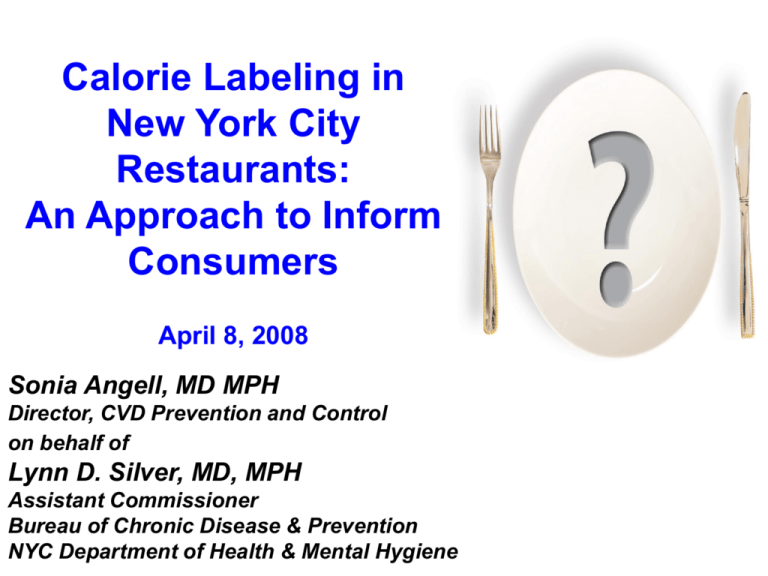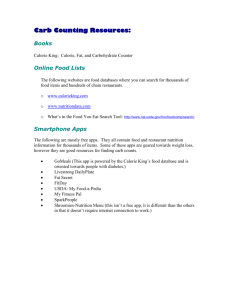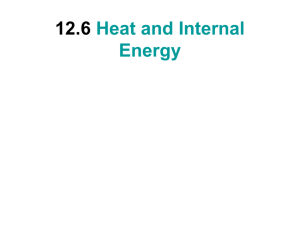Powerpoint
advertisement

Calorie Labeling in New York City Restaurants: An Approach to Inform Consumers April 8, 2008 Sonia Angell, MD MPH Director, CVD Prevention and Control on behalf of Lynn D. Silver, MD, MPH Assistant Commissioner Bureau of Chronic Disease & Prevention NYC Department of Health & Mental Hygiene Obesity is Epidemic in the U.S. 80 Number (millions) 1.8 million more obese U.S. adults each year 4% annual increase 60 40 15.1% 35% Percent 31.1% 30% 25% 66.4 million 20% 15% 10% 20 25.1 million 5% 0 0% 1978 Data from CDC 2001 % of Obese Adults in U.S. # of Obese Adults in U.S. (millions) 100 In NYC Obesity Prevalence Increased >70% in Past Decade • 56% of NYC adults are overweight or obese • 42% of NYC head start children are overweight or obese • In some NYC neighborhoods – 2/3 of adults are overweight or obese Source: NYC DOHMH Community Health Survey, 2004 Key Considerations • Obesity is epidemic and is the second leading cause of preventable death • Obesity is not just a problem of the individual, but also a problem rooted in environmental and community factors • Multifaceted approaches to change our food and physical activity environments are needed now • The evidence base for what to do is still evolving Background People Are Eating Out More Fast Food Associated with Higher Caloric Intake & Obesity • Fast food higher calorie intake – Adults: 205 more calories/day – Children: 155 more calories/day – At once/week, would lead to 3 pound weight gain/year • More fast food more obesity – Adults: 27-31% increase in overweight – Young children: twice as likely to be obese – Among adolescents, more days of fast food predicts increases in BMI Most Consumers Underestimate Calorie Content 2000 956 cal. (58%) 796 cal. (53%) 516 cal. (44%) 1,660 1,500 1,350 Calories 1500 1000 704 834 704 463 cal. (37%) 1,240 777 500 0 Chicken Fajitas Fettuccine Alfredo Patty Melt and Fries Estimated Calories Hamburger and Fries Actual Calories Burton S, Creyer EH, Kees J, Huggins K. 2006 & Backstrand J. Wootan MG. Young LR. Hurley J. , 1997 Nutrition Labeling Influences Decisions • 3/4 of U.S. adults report using nutrition labels on packaged foods • 1/2 of U.S. adults say nutrition information influences their purchasing • When nutrition information for menu items is readily available, consumers choose high-calorie items about 1/3 less often DOHMH Survey Conducted at 275 Restaurants, Representing 13 Restaurant Chains • Conducted March-June 2007 as baseline prior to implementation of §81.50 • Brief exit questionnaire: – Purchase for you only? – Did you see calorie information? – Did you use it? • Asked to provide receipt Information Available Today Is Woefully Inadequate # of Sites* # of Customers Interviewed* % of Customers who Reported Seeing Calorie Information in the Restaurant Domino’s 10 57 0.0% Papa John’s 5 222 0.0% Popeyes 7 512 0.6% Dunkin Donuts 70 2,756 1.3% Starbucks 37 1,285 2.7% Au Bon Pain 2 166 3.7% Burger King 20 1,033 3.8% Yum Brands (Taco Bell, KFC, Pizza Hut) 21 861 4.6% McDonald’s 45 2,593 4.7% Wendy’s 11 474 6.9% Subway 48 1,906 31.3% TOTAL 276 11,865 <8% (3.1% w/o Subway) Brand * Survey customer and site totals vary slightly due to exclusion of customers with missing data for calorie analyses “Supersized” Meals Lead to “Supersized” Waistlines Increasing portion sizes increase caloric intake Regular food item Calories and % recommended daily intake* Larger food item Calories and % recommended daily intake* Calorie difference Item larger by Regular cheeseburger 360 18% Triple Whopper w/cheese 1,230 61.5% 870 242% Chocolate shake (12 oz.) 440 22% Chocolate shake (32 oz.) 1,160 58% 720 164% Big Breakfast 720 36% Deluxe Breakfast 1,400 70% 680 94% * Based on recommended 2,000 daily calorie intake 1 out of 3 Meals Purchased at NYC Chains Had More Than 1,000 Calories >1,250 cal (15%) <500 cal (24%) 1,0001,249 cal (18%) 750-999 cal (21%) 500-749 cal (23%) Preliminary data from 7,308 customers purchasing for themselves only at 11 chains serving lunch Calorie Information Makes a Difference in Amount People Eat Why the NYC DOHMH? Why should a local health department address this? New York City’s Board of Health has enacted countless legal measures to improve the well-being of New Yorkers over the last 200 years including: – Nation’s First Ban on Interior Lead Paint – Modern Tuberculosis Control Provisions – Trans Fat Regulation – Calorie Posting Regulation Why Restaurant Chains in NYC? • Serve food clearly associated with high calorie intake and obesity • Standardized preparation and portion size make accurate calorie information feasible to provide • Disproportionate share of customer traffic assures substantial public health impact – 10% of restaurants serve 35% of NYC meals How Much is on Your Plate? New York’s Calorie Posting Law 12.5.2006 6.2007 §81.50 Approved – First regulation of calorie posting on menus in US to be approved Lawsuit Filed - NYRSA vs. NYCDOHMH 7.1.2007 §81.50 Effective 9.11.2007 Judicial Decision Suspended §81.50 10.24.2007 Existing §81.50 Repealed Modified §81.50 Approved for Public Comment 11.27.2007 Public Hearing on §81.50 1.22.2008 Board of Health Enacts §81.50 for Chain Restaurants 1.30.2008 Lawsuit Filed – NYRSA vs. NYCDOHMH Pending Judicial Ruling 3.31.2008 §81.50 Law Effective Upheld NYC Authority to Mandate; Preempted on a Technicality “The majority of state or local regulations – those that simply require restaurants to provide nutrition information – therefore are not preempted. Such regulations impose a blanket mandatory duty on all restaurants meeting a standard definition such as operating ten or more restaurants under the same name.” – Judge Holwell, September 11, 2007 Examples of Posted Calorie Information Auntie Anne’s Menu Board July 2007 Subway Menu Board July 2007 NYCDOHMH Calorie Labeling Evaluation Plans Evaluating the Calorie Labeling Regulation • Evaluation will assess 1) menu offerings and 2) consumer purchasing using receipts and brief interviews • Random sample of 200 sites and 10,000 customers • Pre/post design starting prior to effective date of regulation (7/1/07) and 1 year later • Begun March 2007, f/u to be determined Calorie Labeling from Coast to Coast Calorie Labeling is only one of NYC’s Steps to Address Obesity… • Physical Activity Program for Children (SPARK) • Daycare Standards • BUILT Environment • Public Procurement • Healthy Bodega Initiative • Etc… Summary • Need to increase our knowledge of what environmental interventions are effective • Can’t wait for gold standard scientific evidence • Adoption of Calorie Labeling is happening in NYC because of the existence of technical expertise, political will, and a respected independent Board of Health • Evaluation will be critical • Like smoke free air, others will follow Calorie Labeling in New York City Restaurants: An Approach to Inform Consumers April 8, 2008 Sonia Angell, MD MPH Director, CVD Prevention and Control on behalf of Lynn D. Silver, MD, MPH Assistant Commissioner Bureau of Chronic Disease & Prevention NYC Department of Health & Mental Hygiene Obesity Trends* Among U.S. Adults BRFSS, 1985 (*BMI ≥30, or ~ 30 lbs overweight for 5’ 4” person) No Data <10% 10%–14% Obesity Trends* Among U.S. Adults BRFSS, 2005 (*BMI ≥30, or ~ 30 lbs overweight for 5’ 4” person) No Data <10% 10%–14% 15%–19% 20%–24% 25%–29% ≥30% Obesity is Epidemic in New York City Obesity Increases Disease Burden • Risk factor for heart disease, stroke, cancer, diabetes and asthma – 4 of the 5 leading causes of death in NYC in 2005, with 40,771 deaths (>70% of all deaths) • Diabetes more than doubled in 10 years – 2004: ~5,000 people on dialysis or with ESRD due to diabetes – 2005: >3,000 lower-extremity amputations – >9,000 New Yorkers blinded by diabetes – >100,000 have eye damage Eating Out Is Associated with Obesity • ~1/3 of our calorie intake comes from food prepared outside the home • Eating out is associated with higher calorie intake and obesity – Children eat almost twice as many calories in restaurant meals compared to meals at home (770 vs. 420 calories) Guthrie JF et al., 2002 & Zoumas-Morse C, Rock CL, Sobo EJ, Meuhouser ML. , 2001 Increasing Calories in Fast Food 1977-1978 1994-1996 419 497 171 284 131 191 721 972 Increase of 251 calories (35%) Board of Health: A History of Regulating the Food Environment Mortality Then § 81.50 As Previously Approved Current Proposal Scope: Applied to FSEs and menu items for which calorie information publicly available on or after March 1, 2007. Scope: All menu items at FSEs in NYC that are one of a group of >15 nationally, offering substantially same menu items, in portions standardized for size and content, that operate under common ownership or control, or as franchised outlets of a parent business, or do business under the same name. How posted: Calorie information posted next to listing of each menu item. Calorie content in size and typeface at least as large as name of menu item or price, whichever is larger. How posted: More flexible. Clearly and conspicuously adjacent or in close proximity clearly associated with menu item. Font and format at least as prominent as either name or price of menu item. Range, item tags: Menu items that come in different flavors & varieties but listed as single food item, list minimum to maximum. Item tags not addressed Range, item tags: Same range requirement, but can omit on menu board when food item tags are available. Item tags to include calorie information Alternative Design: FSEs could propose alternatives within clearly defined parameters Alternative Design: All approvable design elements incorporated – more flexibility on size, placement, drive-thru window stanchions Temporary menu items: Calorie information must be posted if calorie information publicly available Temporary menu items: Does not apply to menu items listed on menu/menu board for less than 30 days Death Rates Due to Diabetes by Race/Ethnicity, NYC, 1990-2001 Among NYC Children in Head Start, 42% are Overweight or Obese Underweight 5% Obese 27% Overweight 15% SOURCE: DOHMH Vital Signs 2006; 5(2):1-2. Healthy Weight 53% Policy Approaches to Address Obesity • Obesity is not just a problem of the individual, but also a problem rooted in environmental and community factors • 2001 Surgeon General’s “Call to Action to Prevent and Decrease Overweight and Obesity” declared obesity a national priority SOURCES: U.S. DHHS, 2001; Galvez, Frieden & Landrigan, 2003 Evaluation Two possible mechanisms of effect: • Consumer choice will change • Menu offerings calorie content will change Estimated Impact of Calorie Posting Regulation in NYC • If calorie reduction in covered FSEs is similar to Subway’s reduction, over the next 5 years: – at least 150,000 fewer New Yorkers would be obese, leading to – at least 30,000 fewer cases of diabetes, – and many other health benefits Other NYC Board of Health Recent Initiatives • Mandatory reporting of Hemoglobin A1C • Daycare regulations on nutrition & physical activity • Trans-fat restrictions






